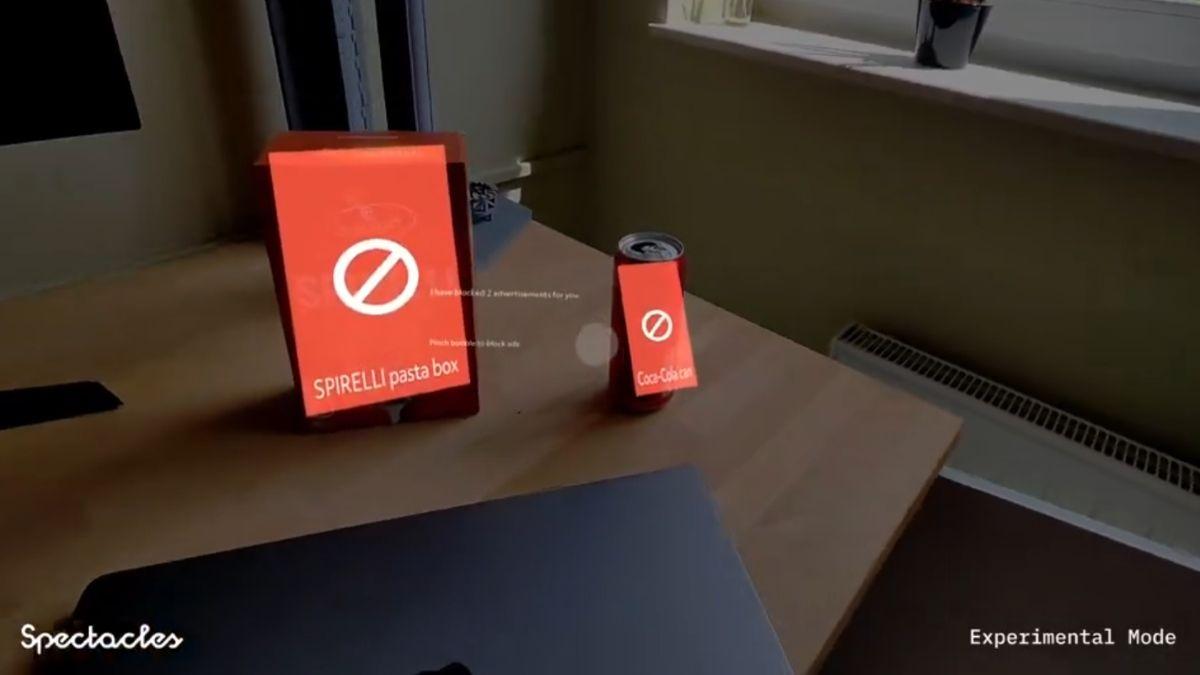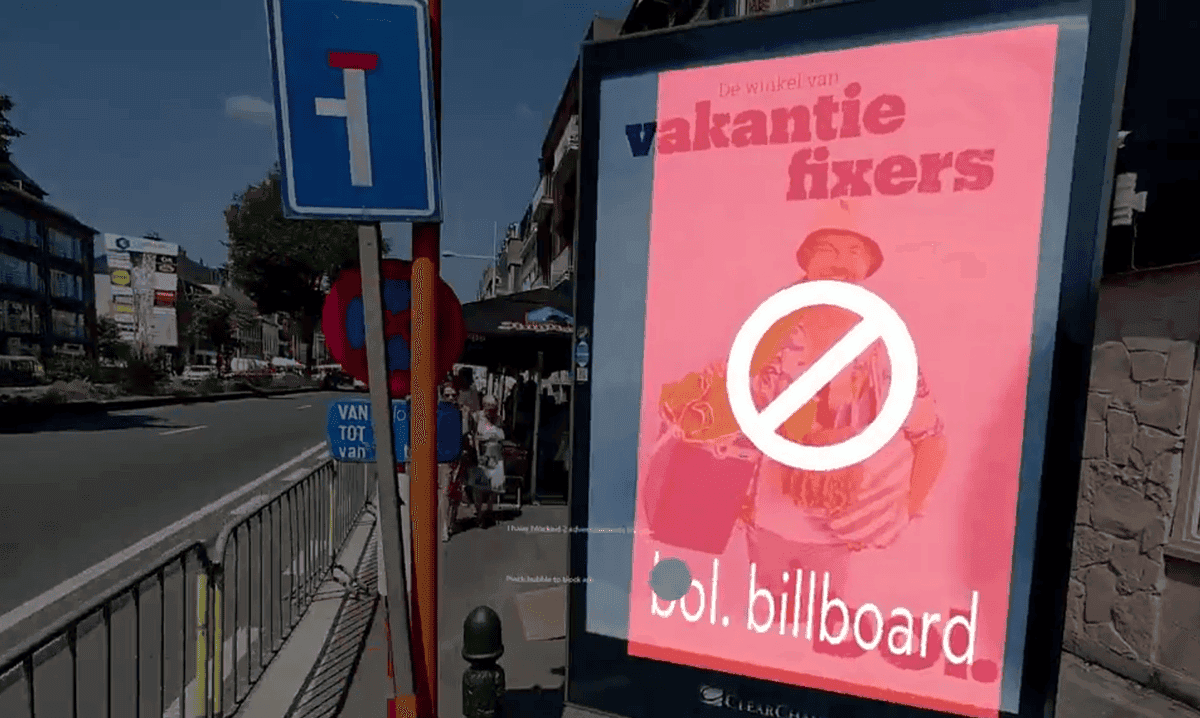Engineer Develops Real-World Ad-Blocking App Using AR Glasses and AI
3 Sources
3 Sources
[1]
Engineer creates ad-block for the real world with augmented reality glasses -- no more products or branding in your everyday life
Say what you will about going outside, but there isn't an AdBlock program for real-life billboards and ads. At least, there didn't use to be. A software engineer on X (formerly Twitter) has built an augmented reality app to identify and block out advertisements, billboards, and product branding in real life. Stijn Spanhove, a Belgian programmer, has engineered an advertisement-blocking app for use with Snap's fifth-generation AR Spectacles. Google's Gemini AI identifies advertisements and brands visible through the smart glasses, and promptly blocks them, replacing the advertisement with a red square, naming and shaming the blocked brand. The above video shows the glasses in action, with the app correctly identifying and visually blocking out ads on posters, pedestrian billboards, and a newspaper. The captured video also shows the glasses blocking out the brand names on food packaging. Spanhove says the project is still very early in its production, but "it's exciting to imagine a future where you control the physical content you see." Spanhove continues to brainstorm the future of the app in his replies, hinting at future features allowing users to replace the glaring red prohibited square with custom photos or lists from a notes app. The app is built from libraries and APIs shared by Snap on its Github on its Depth Cache development, making the app, for now, a Snap Spectacles exclusive experience. Apple Vision Pro and Meta Quest enjoyers will need to wait a bit longer for similar experiences to arrive on their screens. Snap, best known for its flagship social media app Snapchat, has been developing its AR Spectacles since 2016, though the goggles were originally hidden-camera glasses rather than AR devices. While companies like Microsoft and Meta have abandoned or paused their augmented reality projects in recent months and years, Snap has seemingly been carrying the banner forward, with its fifth-gen Spectacles available for $99 per month for developers. While mere mortals without development interest will need to wait a bit longer to experience a true They Live anti-propaganda glasses experience, the questions the app raises are perhaps the most interesting part of it. What will a world look like where we can control what, or perhaps who, we see? At least for now, it will look just like the normal world, just with a few extra red rectangles.
[2]
Software engineer creates a real-life ad block using Snapchat's AR smart glasses, but ultimately ends up making something far more distracting than ads
I utterly despise Google's AI summaries. I dislike how they're placed right at the top of the page, I dislike how prone to hallucinating the answers I'm searching for are, and I dislike that when it does offer something vaguely helpful, it's almost definitely scraped from another human that actually did the legwork. Thankfully, the Bye Bye, Google AI browser extension means I no longer have to glower at them -- if only I could do the same for similar eyesores, like bus stop ads and marketing billboards, in real life. Software engineer Stijn Spanhove is currently tinkering with an AR project that does just that. Using Snapchat's Spectacles and Google's Gemini, he's built an XR app that deploys the power of ad block via the lightweight frame of a wearable (via Tom's Hardware). Unfortunately, as an experimental project that Spanhove is still tinkering with, ads are currently being replaced by glaring red boxes. That quirk aside, the demo video Spanhove shared on X is no less neat. The app's positional consistency is impressive, and is seen 'blocking' out billboards, newspaper ads, and even branded food packaging once activated. This is thanks to the use of Snap's Depth Cache library shared via GitHub, but this also makes the project a Spectacles exclusive for the time being. Besides the Snap exclusivity, the biggest hurdles to my mind are those garish red boxes that are arguably more distracting than the ads themselves. Perhaps developer Stijn Spanhove will in future add the option for users to replace ads with something of their choice -- like an AR mural to Miku Hatsune...hypothetically, I mean. More broadly speaking, big tech keeps trying to make smart specs happen, despite even Meta admitting earlier this year they'd yet to crack a killer use case for their in-development Orion AR glasses. Speaking of Meta, the fact that what you snap or record with the company's Ray-Ban smart glasses may be used to train AI models also turns me off from the whole tech wearables fad. That's all before even mentioning this student project out of Harvard that uses Meta's smart glasses to instantly dox anyone the wearer claps eyes upon. Okay, I admit that's a lot of doom and gloom about wearables -- but you're no longer thinking about my AR Miku Hatsune mural, are you?
[3]
Someone Made an App That Blocks Ads in Real Life
Ads are everywhere: on your phone, your TV, your inbox, and even on the sidewalk, trying to sell you something or the other. While there are ways to avoid the digital stuff, what about real life? But one developer has done the unthinkable and created an app to block ads in real life using Snapchat Spectacles. This story comes from software engineer and AI/XR developer, Stijn Spanhove (X/@stspanho), who shared an X post demoing his upcoming XR app. It works like an ad-blocker for those promotional banners, posters, ads in newspapers, and even Coca-Cola cans. The app is demonstrated running on Snapchat Spectacles and uses Google's Gemini to likely detect ads in the surroundings. According to Stijn Spanhove, the app is based on an open-source sample called the Depth Cache. His app is in early development, and it isn't clear whether Stijn is planning for a public release or keeping it to himself like a pet project. But the possibility of a universal ad blocker is quite exciting, especially because ads have become more prevalent in today's society. Some commenters on his post also suggested replacing the block sign with more natural things like plants and foliage, which would be more pleasing than seeing red rectangles everywhere. Although others suggested adding a to-do list instead. Whatever Stijn plans for the end product, I will be pretty excited to try it out when it comes out. What do you think about it, and would you use an app like this? Let us know in the comments below.
Share
Share
Copy Link
A Belgian software engineer has created an augmented reality app that uses Snap's AR Spectacles and Google's Gemini AI to identify and block advertisements in the real world, raising questions about the future of ad-blocking technology and its implications.
Innovative Ad-Blocking Technology for the Real World
Belgian software engineer Stijn Spanhove has developed a groundbreaking augmented reality (AR) application that brings ad-blocking capabilities to the physical world. Using Snap's fifth-generation AR Spectacles and Google's Gemini AI, the app identifies and blocks advertisements, billboards, and product branding in real-time
1
.How It Works
The app leverages the AR capabilities of Snap's Spectacles to scan the user's environment. Google's Gemini AI then processes the visual input to identify advertisements and branded content. Once detected, the app replaces these elements with red squares, effectively blocking them from the user's view
2
.
Source: Beebom
Technical Implementation
Spanhove's creation is built using libraries and APIs shared by Snap on its Github repository, specifically utilizing the Depth Cache development tools. This makes the app currently exclusive to Snap Spectacles, with potential adaptations for other AR platforms like Apple Vision Pro and Meta Quest yet to be developed
1
.Current Limitations and Future Possibilities
While the app successfully identifies and blocks various forms of advertising, including posters, pedestrian billboards, newspaper ads, and even food packaging, it is still in its early stages of development. The current version replaces ads with conspicuous red squares, which some users find more distracting than the original advertisements
2
.Spanhove has hinted at potential future features, such as allowing users to replace blocked content with custom photos or personal notes. Some observers have suggested more natural replacements like plants or foliage to create a less jarring visual experience
3
.Related Stories
Implications and Ethical Considerations

Source: Tom's Hardware
This innovative application raises important questions about the future of augmented reality and user control over visual content in physical spaces. As Spanhove notes, "It's exciting to imagine a future where you control the physical content you see"
1
.However, the technology also prompts discussions about the ethical implications of selectively altering one's perception of reality. Questions arise about the potential impact on businesses relying on physical advertising and the broader consequences of allowing individuals to curate their visual environment to this extent.
The Future of AR Wearables
This project comes at a time when major tech companies are reassessing their strategies in the AR wearables market. While Microsoft and Meta have scaled back their AR initiatives, Snap continues to push forward with its Spectacles, offering them to developers for $99 per month
1
.As AR technology continues to evolve, applications like Spanhove's ad-blocker may play a crucial role in shaping the future of how we interact with and perceive our surroundings. The development of such tools could potentially influence the direction of AR wearable design and functionality in the coming years.
References
Summarized by
Navi
[1]
Related Stories
Recent Highlights
1
Google launches Gemini 3 Flash as default AI model, delivering speed with Pro-grade reasoning
Technology

2
OpenAI launches GPT Image 1.5 as AI image generator war with Google intensifies
Technology

3
OpenAI launches ChatGPT app store, opening doors for third-party developers to build AI-powered apps
Technology








